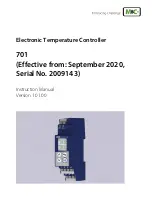
ZENN
iO
AVANCE Y TECNOLOGÍA
vwww.zennio.com
14
14
Figure 3.3. Mode window
Individual control:
when this option is selected, all the described working modes will be
selectable through one specific 1-bit communication: this means that 5 objects will be
deployed for establishing one of the available modes (Auto, Cool, Fan, Heat and Dry), by
sending the value "1" through them, as well as 5 more objects for reflecting the status (active,
not active) of every individual mode.
1 byte control:
when this option is selected, the working modes can be controlled
through a unique 1-byte communication object, "A/C Unit - Modes [1 byte]", by sending the
value corresponding to the mode to be activated. It is also possible to check at any time the
current working mode of the A/C unit, via the 1-byte object "A/C Unit - Modes Status [1 byte]".
Simplified control:
when this option is selected, the 1-bit object "A/C Unit - Simplified
Mode" will be enabled. It allows establishing the desired mode: Cool mode (writing the value
"0" in the object), or Heat mode (writing the value "1"). There is no status object associated to
this control object.
The three control types can be enabled jointly, making it possible to control the functioning mode in
the desired manner at any time. Note that, anyway, changing from one mode to another has two
major consequences: first, the sending of the mode switch order to the machine; and second, the
commutation in IRSC-Zone, if this applies, from one thermostat and grille control type to another.
Note:
The algorithm for controlling the zone airing grilles (open/close) can be consulted in Annex II.
In addition, section 3.5 and Annex III explain the calculation process of the general setpoint, based
on the zone setpoint temperatures and the current working mode.















































